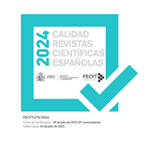Georadar, georradar, georrádar… Nuevas pautas para clasificación de la variación formal neológica en español
Resumen
La variación formal es una de las principales características de los neologismos, que pasan por una fase de inestabilidad en este sentido, previa a su completa inclusión en los códigos. En el estudio que presentamos, partimos de un corpus de más de 6000 unidades recopiladas durante ocho años en prensa escrita para observar y clasificar las principales tendencias de variación que se dan en el español de España actual. Para ello, hemos diseñado un baremo de puntuación que favorece a las unidades más estables en detrimento de las demás. Dicho baremo contempla elementos como la frecuencia absoluta de las unidades, el número de variantes formales que remiten a una misma realidad o la diferencia de la frecuencia absoluta que se da entre dichas variantes. Los resultados confirman la existencia de nuevos tipos de variación formal relevantes, con unas tendencias claras en lo que respecta a la alternancia en la separación o la unión con y sin guion de elementos léxicos, o los intentos de adaptación a la norma ortográfica.
Descargas
Descarga artículo
Licencia
La revista Círculo de Lingüística Aplicada a la Comunicación, para fomentar el intercambio global del conocimiento, facilita el acceso sin restricciones a sus contenidos desde el momento de su publicación en la presente edición electrónica, y por eso es una revista de acceso abierto. Los originales publicados en esta revista son propiedad de la Universidad Complutense de Madrid y es obligatorio citar su procedencia en cualquier reproducción total o parcial. Todos los contenidos se distribuyen bajo una licencia de uso y distribución Creative Commons Reconocimiento 4.0 (CC BY 4.0). Esta circunstancia ha de hacerse constar expresamente de esta forma cuando sea necesario. Puede consultar la versión informativa y el texto legal de la licencia.











